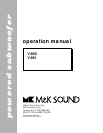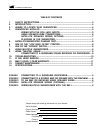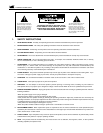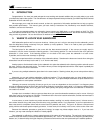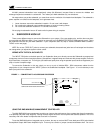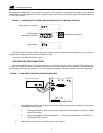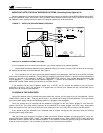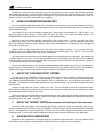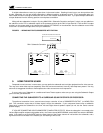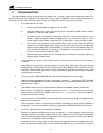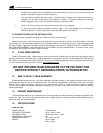
If multiple subwoofers are used, try to place them in the same location. Stacking is best, but you can also put them side
by side. Alternately, you can put multiple subwoofers in different locations, at adjacent corners. This is appropriate when you
have limited choices in locating the subwoofer and none of the available locations work well. Try to place multiple subwoofers
at equal distances from the listening position to avoid phase cancellation.
Wiring with two subwoofers is simple. By using M&K’s RM-1 Subwoofer Controller, see figure 5, simply run one cable from
the sub/mono on the LFE or subwoofer output on the processor/receiver to the RM-1’s input terminal. From the RM-1’s output
terminal, run the proper cable to the input terminal marked “LEFT/MONO” on the subwoofer. Use the calibration control knob
on the RM-1 to control the output level of all your subwoofers.
FIGURE 5 - WIRING MULTIPLE SUBWOOFERS WITH THE RM-1
9. HOME THEATRE USAGE
Compared to music sources, in some cases, you may prefer the subwoofer set to a higher playback level for video sources.
This may occur when video sources (especially older films and some television) have very little deep bass present. You may
also want to exaggerate the effect to make spectacular video sources even more impressive!
If you are using your Subwoofer in a multichannel Home Theatre system, make sure you are using the Subwoofer Output
jack to connect your subwoofer.
CONNECTING THE SUBWOOFER TO A SURROUND SOUND RECEIVER OR PROCESSOR:
The preferred connection from a surround sound amp or controller is from a SUBWOOFER OUTPUT (or MONO) RCA
jack. This connection insures that a full bass signal is fed to the subwoofer. If your component doesn't have a subwoofer
output jack, connect the Subwoofer to the front Left and Right channel speaker outputs (do not use the Center channel
speaker output).
IF YOU ARE CONNECTING YOUR SUBWOOFER TO AMPLIFIER OUTPUTS: When the subwoofer is connected to the
Left and Right amplifier outputs using speaker wires, the Center channel WIDE/NORMAL switch MUST be set to the NORMAL
mode. If the switch is set to the WIDE mode, the bass content of the Center channel will not be fed to the subwoofer, and a
significant amount of the bass in the material you are listening to will be lost.
POWERED SUBWOOFER
9
SUB 1
SUB 2
INPUT
RM-1
SUBWOOFER
CONTROLLER
100
PHASE
9351 Deering Avenue, Chatsworth, CA 91311 818/701-7010 www.mksound.com
MILLER & KREISEL SOUND CORPORATION
RIGHT
INPUT
LOW PASS FILTER
(Hz)
FROM AMPLIFIER
50
75
60
125
T
2 AMP
120 VAC 50/60 Hz
RIGHT LEFT
LEFT/MONO
SLOW-BLOW
ATTENTION:
DEBRANCHER AVANT DE
REMPLACER LE FUSIBLE.
UTILIZER UN FUSIBLE
DE RECHANGE DE MEME TYPE.
CAUTION:
DISCONNECT SUPPLY CORD
BEFORE CHANGING FUSE.
REPLACE FUSE ONLY
WITH SAME TYPE.
CAUTION
RISK OF ELECTRIC SHOCK
DO NOT OPEN
AVI S:
RISQUE DE CHOC ELECTRIQUE. NE PAS OUVRIR.
+
-
BASS LEVEL
+3 dB
+6 dB
- 3 dB
- 6 dB
REFERENCE
+9 dB
BYPASS
VARIABLE
!
100
PHASE
9351 Deering Avenue, Chatsworth, CA 91311 818/701-7010 www.mksound.com
MILLER & KREISEL SOUND CORPORATION
RIGHT
INPUT
LOW PASS FILTER
(Hz)
FROM AMPLIFIER
50
75
60
125
T
2 AMP
120 VAC 50/60 Hz
RIGHT LEFT
LEFT/MONO
SLOW-BLOW
ATTENTION:
DEBRANCHER AVANT DE
REMPLACER LE FUSIBLE.
UTILIZER UN FUSIBLE
DE RECHANGE DE MEME TYPE.
CAUTION:
DISCONNECT SUPPLY CORD
BEFORE CHANGING FUSE.
REPLACE FUSE ONLY
WITH SAME TYPE.
CAUTION
RISK OF ELECTRIC SHOCK
DO NOT OPEN
AVIS:
RISQUE DE CHOC ELECTRIQUE. NE PAS OUVRIR.
+
-
BASS LEVEL
+3 dB
+6 dB
- 3 dB
- 6 dB
REFERENCE
+9 dB
BYPASS
VARIABLE
!
SURROUND PROCESSOR OR RECEIVER
SUB / MONO OUT
RM-1 Subwoofer Controller



